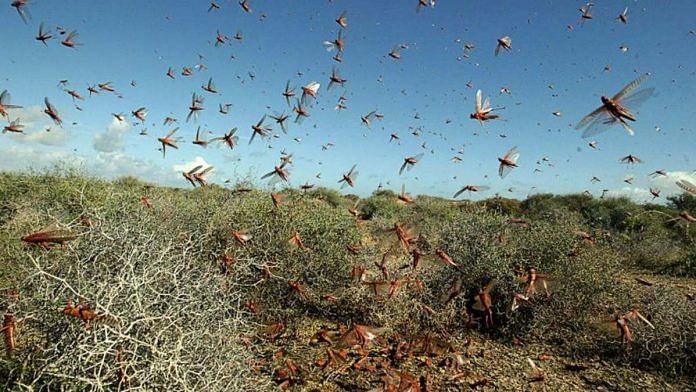Nimli: The ongoing locust attack in Rajasthan and Gujarat that has destroyed crops over nearly 1.7 lakh hectares of farmland is an indirect consequence of climate change, said experts Sunday at the Centre for Science and Environment’s (CSE) annual media conclave in Rajasthan.
Environmentalists and journalists from across India have gathered for the Anil Agarwal Dialogue 2020, held from 9 to 11 February, in Rajasthan’s Nimli to discuss several key issues on the environment.
Sunita Narain, director general of CSE, told mediapersons Sunday that most people are unaware how climate change has been causing havoc among Indian farmers even as they know about the Australian bush fires.
Union Agriculture Minister Narendra Singh Tomar had told the Rajya Sabha last week that 88 per cent of the total 1,68,548 hectares of affected farmland in Rajasthan and Gujarat witnessed a severe crop loss of more than 33 per cent.
Groups of adult locusts have also been spotted in Punjab and Haryana, but no crop damage has yet been reported from these states.
Also read: Swarms of locusts damage wheat, cumin, potatoes crops in Gujarat
‘Plague-like situation’
Anil Sharma, a desert locust expert who had recently retired from the locust circle office in Rajasthan, said one needs to know the cyclonic patterns in the Middle East in 2018 to understand what has triggered locust attacks in India.
In his presentation, Sharma explained how rainwater had gathered in different parts of the arid desert that sprawls over Saudi Arabia, Oman, the United Arab Emirates and Yemen after it was hit by Cyclone Mekunu in May 2018.
This created favourable breeding conditions for desert locusts.
In October that year, the Arabian Peninsula was hit by Cyclone Luban, which created more favourable conditions for locusts to breed.
In search of food, these locusts then flew eastwards towards Pakistan and India. “They come very suddenly. This insect is dreaded most by farmers across the world. The swarms are so thick that they even block sunlight,” Sharma said.
He also said while locust invasions are normal, the current attack in India has been a “plague-like situation” that experts have not seen before.
Pakistan, meanwhile, has declared locust invasion in the country a “national emergency”.
A separate swarm — also originating from the Middle East — has also made its way to Africa, triggering fears of food crisis in the region.
Delayed retreat of Indian rainfall
Locust swarms are known to retreat by November every year but a delayed retreat of the seasonal rainfall in India has created favourable breeding conditions for locusts in the Thar desert.
In June 2019, the Indian side of the Thar desert had received unexpected rainfall.
Sharma blamed climate change for turning deserts into watery landscapes. He also said that lizards, which usually prey on locusts, are now not found abundantly in desert areas.
Farmers usually spray large amounts of pesticides to protect crops but this has not only harmed harvests but also failed to keep locusts at bay.
Also read: These bugs are eating into Pakistan’s already fragile economy



